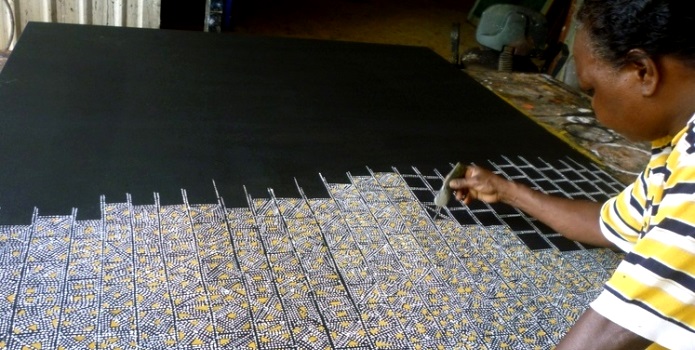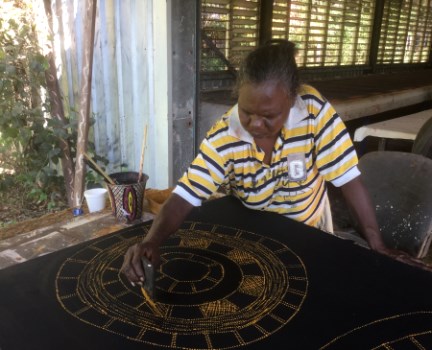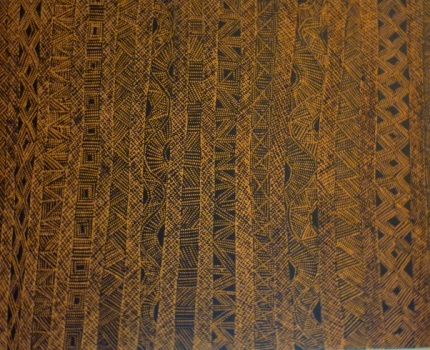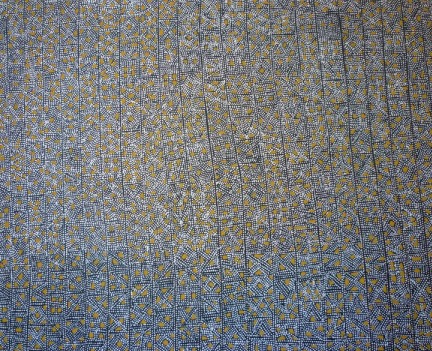The Life & Art of Maria Josette Orsto


By: David Wroth, Japingka Gallery, 2016
The life and art of Maria Josette Orsto are entwined with many firsts. She was the first female member artist of Tiwi Design in Nguiu on Bathurst Island in the mid 1980s. She would become the first female member artist of Munupi Arts & Crafts, the youngest of three art centres on the Tiwi Islands. This opened at Pularumpi (Garden Point) on Melville Island in 1990. She was also commissioned to create a major public artwork welcoming visitors to Darwin Airport. This is a gateway to many arts centres located in the top end of the Northern Territory. Maria moved with her family back to Nguiu in 1992 where she creates artworks at Tiwi Design.
Born in 1962 at Pularumpi, Maria’s life and professional practice have straddled both islands that comprise the Tiwi Islands. The stories from her family connect her to her father’s country at Imalu on Melville Island and to her mother’s country at Wangurruwu (Marluwu) on Bathurst Island. Maria’s father Declan Apuatimi was a well-known and respected artist and ceremony man. Her mother was the acclaimed artist Jean Baptiste Apuatimi, whose work was included in the first National Indigenous Art Triennial exhibition held at the National Gallery of Australia. This work was titled Culture Warriors, 2007. Maria was subsequently invited to participate in the second triennial exhibition UnDisclosed in 2011.
Many of Maria’s designs are inspired by the endless hours spent watching and assisting her father paint from a young age. It was during this time she also became a competent carver. This marked a lifelong journey of learning about important stories and designs that connect her family to the broader cosmology of Tiwi culture. These belief systems connect all Tiwi people to country, place and ceremony. As an artist Maria had to discover and confirm how she could visually express these traditions in her art making.
“I have been making art since when I was 12, but then I was still with my father doing carving, especially carving I learn. Then I went to school and started painting there and went back home to help my father paint all the spears and figures”.
There have been many developments throughout Maria’s professional practice, working across various material and media, ideas and subject matter. There has also been the development of self-confidence over time in undertaking the larger scale works that are bolder in approach yet detailed in composition.
Miyinga is the Tiwi name for scarification. It has close reference to sorry business ceremony that is conducted and undertaken by Tiwi people. The scar becomes a physical reminder of a particular person’s memory. It therefore has permanence and gives meaning. In Miyinga, commissioned in 2015 for the Being Tiwi exhibition, Maria has created a contemporary work of art that is informed by her world view, reaching across the dichotomy of the Tiwi world and the western world.
Just as it is the ochre that is painted on the body that gives meaning to ceremony, so too with Maria in her approach to the painting of ochre on canvas. The intricate designs in vibrant white ochre are painted over the top of a black background that suggest the symbolic presence of the skin of the artist. There are subtle but minimal shifts and use of colour, primarily in yellow ochre, that has been layered into the composition of the Miyinga design. The process Josette Orsto undertakes is meticulous. After painting several layers of the base colour, the composition of the canvas is divided up by columns of detailed designs that have been painted using a pwoja. The pwoja is a traditional Tiwi ironwood comb, and the edge of the comb is dipped in ochre and applied to the canvas. This object is also traditionally used in ceremony, with the ochre being pressed onto the skin to create designs or jilmara. This is slowly built up as Maria begins to fill the white and yellow ochre in sections over the top of the black background.
The movement and subtle shifts of light and tone that are created in the patination are uniquely hers. These contemporary designs bridge a space Maria has been able to create where she entwines the old traditions and the new. She has freely drawn upon her lived experience and the knowledge passed down from her mother and father to re-interpret aspects of Tiwi cultural maintenance in a contemporary way. Maria has successfully done this in her work across print media, painting on bark and canvas and in her earlier works on batik.
The last bodies of work undertaken with her mother and staff from Northern Editions Gallery, Charles Darwin University. Maternal Lines 2013 pushed and redefined Tiwi print media. It featured etching and aquatint as well as intaglio and relief prints created by Jean Baptiste Apuatimi and Maria. There was a selection that were sewn into three dimensional forms by Maria to resemble tunga baskets. By turning the two dimensional works into three dimensional sculptural forms, they became like cultural objects that were normally made, shaped, created and painted out of bark, and were transformed in an impressive and innovative process.
“Yes, I love doing art because it brings no sadness, no thinking about anything bad. Um, help me to do – bring my memory back and designs, what I’m doing on the next canvas and paper.”
This article is courtesy of Tiwi Design, quotations are from an interview with the artist at Tiwi Design on 26 February 2015.




